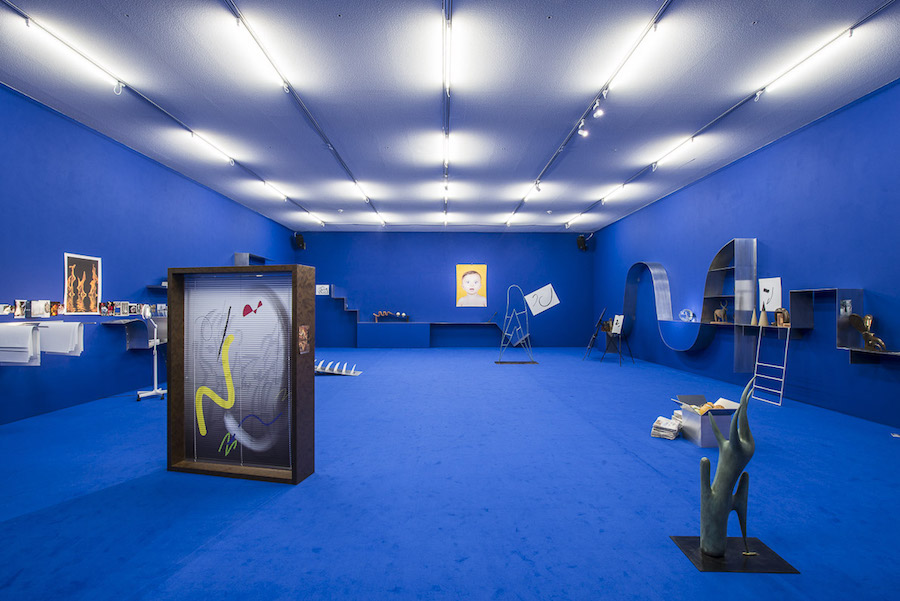
When Heinrich Wölfflin makes concluding observations on the nature of history in Principles of Art History (1932), in spite of himself, he cannot help reaching for images of complexity. How do we account for cessation and recommencement of art historical periods? ‘Only a spiral would meet the facts,’ he writes. How do we speak of the relations between art of different nations? ‘Not the line but the web of lines,’ he admits. ‘Not the established single form but the movement of form.’ There is tension between linear ways of telling and complex, multiple being. The old and the new, the historian tells us, ‘dovetail’.
These are a few of the ‘big questions’ — unfashionable in contemporary art — French, New York-based artist Camille Henrot poses in her exhibition ‘The Pale Fox’, installed at Chisenhale in London’s East End. With ‘The Pale Fox’, a commission that developed out of her film Grosse Fatigue (2013) (for which she was awarded the Silver Lion at the Venice Biennale for most promising young artist), Henrot poses perhaps the biggest question of all: ‘what is creation?’ From the macro to the micro, the artist’s studio, to the universe, how do things come into being, live, and die away?
The title of Henrot’s exhibition is taken from an influential anthropological study of the Dogon people of Mali, co-authored by Marcel Griaule and Germaine Dieterlen, and published by the latter in 1965. Through his multiple initiations by an elder, Griaule exposed the Dogon’s world view, cosmology, and philosophical system with unparalleled completeness. For the Dogon, he learnt, a creation myth served as a blueprint for all facets of society. Within this myth a fox, borne of thwarted intercourse with the earth, represents disorder and chaos but also creation, bringing about the formation of the sun.
At Chisenhale Henrot has painted the walls a rich blue; these are matched in colour by the carpeted floor. For Henrot the blue references Yves Klein and his eponymous tone of blue, but also, as a ground, enables an ambivalent relation between intimacy and universal distance. Upon entry ambient music envelops the viewer, initiates them into this total environment. (Sinologist François Jullien on blandness comes to mind: blandness is ‘the embodiment of neutrality… at the point of origin of all things possible’.) Following the space’s walls is a band — a more or less continuous structure — that twists, turns and flattens out into shelves. Uneven accumulations of E-bay found objects, loose Chinese ink drawings, ‘primitive’ Surrealist bronze and ceramic sculpture, and digital prints and images, often by Westerners looking at non-Westerners, displayed on tablet devices cluster at the foot of the shelves, or are displayed on its polished surfaces.
The shelf is a timeline, activated to represent periods in cosmic and human history according to Henrot’s alignment of the gallery to points of the compass. Each point is further associated with the four Classical elements of air, water, earth and fire. The West wall Henrot names ‘The principle of being (air): How things start.‘ The North wall, immediately in front as you enter the gallery, ‘The law of continuity (water): How things unfold.’ The East wall is ‘The principle of sufficient reason (earth): Where the limits are.’ And, finally, the South wall is ‘The principle of the indiscernible (fire): How things disappear.’ ‘I decided that there would be a different age of humanity attributed to each of the different walls,’ Henrot explained in the gallery interview. ‘I was already very interested in how the age of humanity can be related to the age of the universe.’
Henrot’s accumulation of objects and images achieves a global image willfully reminiscent of the great museum collections of the world. However, against an accumulation that might dedifferentiate, produce a kind of ambivalence to things, Henrot seeks to particularise, to emphasise unresolved complexity in heterogeneity. There is a will for objects and images to retain their aura, their special powers within a field of others. ‘Synthesis,’ Henrot says, ‘is never really interesting, it’s almost like a bourgeois solution. It’s the dynamic between thesis and antithesis that is interesting.’
For Henrot the French philosopher Gilles Deleuze’s notion of the fold is an ideal image of complexity. Speaking of the fold Deleuze invokes a world of superabundance, with no boundary between the organic and the inorganic. Each folds into the other in a continuos ‘texturology’. Henrot’s assembly of images and objects — her art — is able to evoke a span far exceeding the limits of art history’s knowledge, while, irresistibly, holding a mirror to contemporary Western society.
